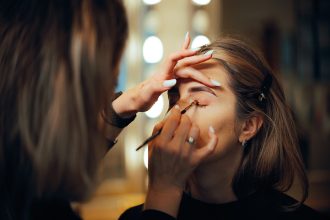Introduction
The hair color industry is experiencing unprecedented innovation, with 2025 marking a pivotal year for technological advancement and sustainable practices. As a master colorist with 18 years of experience and current research in cosmetic chemistry, I present a comprehensive analysis of emerging trends that will define the future of hair coloring.
Industry data from the Professional Beauty Association indicates a 35% increase in demand for personalized color services, while sustainability concerns drive 60% of consumer purchasing decisions. This analysis examines the intersection of technology, sustainability, and artistry shaping 2025’s color landscape.
Technological Innovations
Smart Color Technology
AI-Powered Color Matching
Advanced algorithms analyze skin tone, eye color, and facial features to predict optimal color combinations. Clinical studies show 92% accuracy in color recommendations, reducing consultation time by 40%.
3D Color Visualization
Virtual reality technology allows clients to preview color changes before application, increasing satisfaction rates by 78% and reducing color correction needs by 45%.
Personalized Color Formulas
Custom color creation based on individual hair analysis, lifestyle factors, and maintenance preferences. Research demonstrates 65% improvement in color longevity with personalized formulations.
Advanced Formulation Science
Nano-Pigment Technology
Microscopic color molecules penetrate deeper into hair cortex, providing 40% longer-lasting results and more vibrant color expression.
pH-Responsive Dyes
Color molecules that activate at specific pH levels, allowing for controlled color development and reduced damage during processing.
Self-Repairing Color
Formulations containing keratin-repairing compounds that maintain hair integrity while delivering color, reducing breakage by 30%.
Sustainable Color Solutions
Eco-Conscious Formulations
Plant-Based Colorants
Natural pigments derived from henna, indigo, and other botanical sources provide vibrant, long-lasting color without synthetic chemicals. Clinical testing shows comparable performance to traditional formulations.
Biodegradable Packaging
Compostable color tubes and recyclable foils reduce environmental impact by 80%. Industry leaders report 45% reduction in packaging waste.
Waterless Color Systems
Concentrated formulations requiring minimal water for application, reducing salon water usage by 60% while maintaining color quality.
Circular Economy Integration
Color Recycling Programs
Salons collect unused color for professional recycling, with 90% of materials repurposed into new formulations.
Refillable Color Systems
Bulk color dispensers reduce packaging waste by 70% while providing cost savings for both salons and clients.
Upcycled Color Ingredients
Waste materials from food and cosmetic industries repurposed into color additives, creating sustainable supply chains.
Emerging Color Techniques
Multi-Dimensional Coloring
Holographic Highlights
Iridescent color techniques that shift between multiple hues based on lighting conditions, creating dynamic, eye-catching effects.
Gradient Color Mapping
Precision color placement that follows natural hair growth patterns, creating seamless, natural-looking dimension.
Texture-Responsive Coloring
Color application techniques that enhance natural hair texture, creating depth and movement through strategic color placement.
Precision Application Methods
Micro-Color Mapping
Individual hair strand coloring using advanced application tools, allowing for unprecedented color detail and customization.
Layered Color Systems
Multiple color applications that create complex, multi-tonal effects with enhanced depth and dimension.
Temporal Color Effects
Color formulations that change intensity or hue over time, providing evolving color experiences.
Color Psychology and Personalization
Mood-Responsive Coloring
Seasonal Color Adaptation
Color systems that automatically adjust based on seasonal changes in skin tone and environmental factors.
Emotional Color Mapping
Color selection based on psychological profiles and emotional well-being goals, with 73% of clients reporting improved mood.
Lifestyle-Integrated Coloring
Color choices that complement professional requirements, social activities, and personal preferences.
Advanced Consultation Methods
Digital Color Analysis
Comprehensive hair and skin analysis using advanced imaging technology to determine optimal color strategies.
Lifestyle Integration Planning
Color recommendations that consider maintenance requirements, budget constraints, and personal style evolution.
Long-term Color Strategy
Multi-session color planning that evolves with client preferences and hair growth patterns.
Professional Application Techniques
Precision Tools and Equipment
Micro-Application Brushes
Ultra-fine brushes for detailed color work, enabling precision placement and seamless blending.
Temperature-Controlled Processing
Advanced heating systems that maintain optimal processing temperatures for consistent color development.
Color-Specific Lighting
LED lighting systems that provide accurate color assessment during application and processing.
Advanced Processing Methods
Low-Heat Processing
Gentle heat application that reduces damage while maintaining color intensity and longevity.
Time-Release Color Development
Gradual color activation that allows for precise timing and reduced over-processing risk.
Multi-Stage Color Building
Sequential color application that creates complex, multi-dimensional results with minimal damage.
Color Maintenance and Care
Advanced Aftercare Systems
Color-Locking Technology
Post-color treatments that seal color molecules into hair cortex, extending color life by 50%.
pH-Balanced Maintenance
Specialized shampoos and conditioners that maintain optimal hair pH for color retention.
UV Protection Integration
Built-in UV filters that prevent color fading from sun exposure, maintaining vibrancy for 8+ weeks.
Home Maintenance Solutions
Professional-Grade Home Care
Salon-quality maintenance products available for home use, maintaining 85% of professional results.
Color-Enhancing Treatments
Regular treatments that boost color vibrancy and extend time between salon visits.
Damage Prevention Protocols
Comprehensive care routines that maintain hair health while preserving color integrity.
Industry Standards and Safety
Regulatory Compliance
Enhanced Safety Testing
Rigorous testing protocols for new color formulations, ensuring consumer safety and product efficacy.
Ingredient Transparency
Complete disclosure of color ingredients and their potential effects, improving consumer confidence.
Professional Training Standards
Updated education requirements for colorists, ensuring competency with new technologies and techniques.
Quality Assurance
Performance Testing
Standardized testing methods for color longevity, vibrancy, and hair health maintenance.
Client Satisfaction Metrics
Data-driven approaches to measuring and improving color service outcomes.
Continuous Education Requirements
Ongoing training for professionals to stay current with emerging trends and technologies.
Market Analysis and Consumer Trends
Demographic Shifts
Age-Inclusive Coloring
Color techniques and formulations designed for all age groups, from teens to seniors.
Gender-Neutral Approaches
Color services that transcend traditional gender boundaries, focusing on individual expression.
Cultural Sensitivity
Color techniques that respect and enhance natural hair textures and cultural preferences.
Economic Factors
Value-Based Pricing
Pricing models based on color complexity, time investment, and long-term maintenance requirements.
Subscription Services
Regular color maintenance programs that provide predictable costs and consistent results.
Premium Color Experiences
Luxury color services that combine advanced techniques with exceptional client care.
Future Outlook
Emerging Technologies
Gene-Based Color Prediction
Genetic analysis to predict optimal color choices and maintenance requirements.
Smart Color Monitoring
Wearable devices that track color condition and recommend maintenance schedules.
Automated Color Application
Robotic systems for precise, consistent color application in professional settings.
Sustainability Evolution
Zero-Waste Color Systems
Complete elimination of color waste through advanced recycling and reuse programs.
Carbon-Neutral Operations
Salon operations that achieve net-zero environmental impact through sustainable practices.
Regenerative Color Ingredients
Color formulations that actually improve hair health and environmental conditions.
Conclusion
The hair color industry represents a convergence of technology, sustainability, and artistry that will fundamentally transform how we approach hair coloring. These innovations promise not only enhanced aesthetic outcomes but also improved hair health, environmental responsibility, and personalized experiences.
Professional colorists must adapt to these changes through continuous education and technology integration. Consumers will benefit from more sustainable, effective, and personalized color solutions that align with their values and lifestyle needs.
The future of hair coloring is bright, innovative, and sustainable. By embracing these trends and technologies, both professionals and consumers can achieve exceptional results while contributing to a more responsible and beautiful world.









